Skip the Mona Lisa and See these Paintings Instead at the Louvre
- SUBSCRIBE
- ALREADY SUBSCRIBED?
BECOME A BONJOUR PARIS MEMBER
Gain full access to our collection of over 5,000 articles and bring the City of Light into your life. Just 60 USD per year.
Find out why you should become a member here.
Sign in
Fill in your credentials below.
The Musée du Louvre– the former palace to the Kings of France and now the largest museum in the world– is filled with more than 38,000 pieces of art. A visit to the Louvre can be daunting and overwhelming. With the crowds, including the large tour groups, that move like a swarm of insects, it’s easy to become frustrated and want to leave. Many people arrive with a list of things to see, like the Mona Lisa, Venus de Milo, and Winged Victory, and often times they leave after seeing these few things. The Musée du Louvre, is my favorite place to spend hours and days inside its historic walls and under its ceilings that tell the story of its past and that of France. It is much more than a museum, as the residence of the Kings and Emperors that each left their mark on it, the museum reads like an encyclopedia once you know the initials and the allegories each ruler held a fondness for.
Recently there have been reports about overcrowding at the Mona Lisa, and the museum has taken measures to slow the tide of visitors. (If you have a Museum Pass, you’ll still need to make a (free) online booking with a designated date and time to enter the museum). In light of this, I want to share what makes the Louvre so amazing far past Madame Mona Lisa. This list takes you past the paintings that you think you “should” see, and the ones that really have their own tale to tell.
Let’s start with two of my favorite paintings. Both paintings depict events in the history of France, and include the Patron Saint of Paris and headaches, Saint Denis.
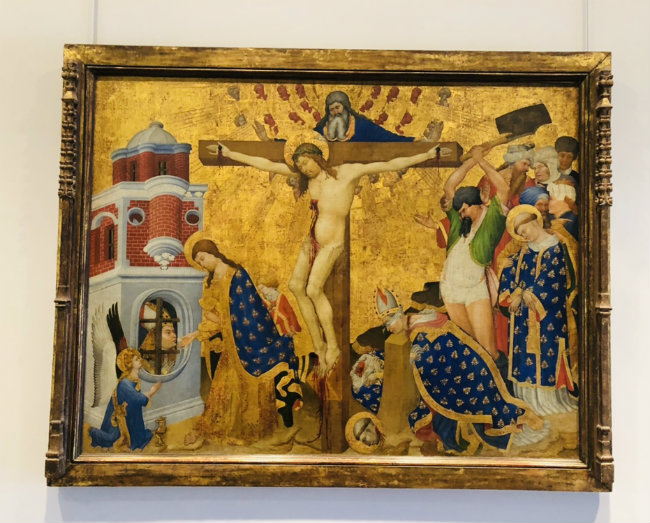
The altarpiece of Saint Denis by Henri Bellechose. Photo: Claudine Hemingway
Henri Bellechose’s The Saint Denis Altarpiece was painted between 1415 and 1416 for Jean sans Peur, the Duke of Burgundy. It was destined for the Carthusian monastery at Chartreuse de Champmol in Dijon, the church dedicated to the Holy Trinity, and gifted by the powerful dukes of Burgundy. The center of the paintings holds the Holy Trinity with Christ on the cross, while God the Father looks over him and the holy spirt. The painting depicts two episodes in the life of Saint Denis. Saint Denis made waves as he and his fellow priests were rapidly converting people to Christianity. He was imprisoned and sentenced to death, along with Saint Rusticus and Saint Eleutherius, circa 250 ad. On the left, the patron saint of Paris is jailed and given his last communion by Christ and two angels. On the right side of the painting, Saint Denis appears with his head on the block as the brutal executioner is swinging an axe. The three would be beheaded and martyred and venerated as saints. However, the story of Saint Denis continues. The tale goes that he picked up his head and walked from the hill, Mons Martyrum, the mountain of martyrs– now known as Montmartre– and walked several miles, carrying his severed head before he stopped at what is now the Basilica of Saint Denis, north of Paris. You can see this painting in the Richelieu wing, 2nd floor, salle 834.
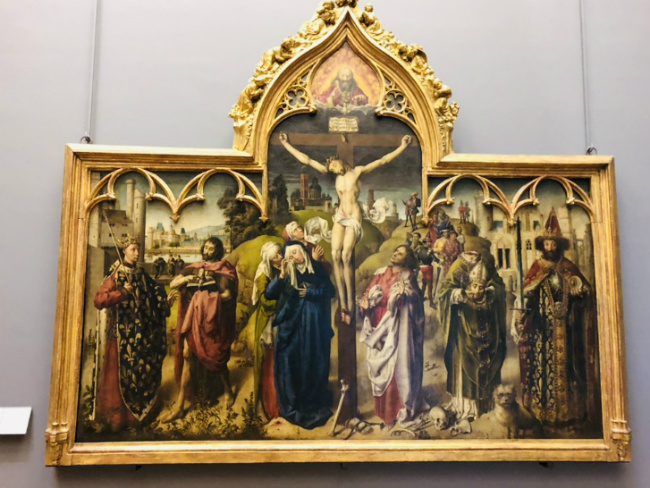
The Crucifixion of the Parliament of Paris. Photo: Claudine Hemingway
Close nearby is the other painting that includes Saint Denis, The Crucifixion of the Parliament of Paris. Painted in 1450 and intended for the walls of the main court of France, it was to serve as a reminder of the moral responsibility the court was to take with its verdicts. However, this painting holds many stories in its flamboyant Gothic frame. In the center we see Christ on the cross and God the Father looking down on him– like in the Saint Denis painting. Below on his left is the Virgin Mary being comforted by Mary Magdalene and, on his right, Saint John the Evangelist. On the left of the painting we see Saint Louis, the only French king that would become a saint, known for bringing to Paris the Crown of Thorns that Christ is wearing in this painting. Saint Denis is wearing a blue robe covered with the fleur-de-lis, the symbol of the monarchy. To his left, Saint John the Baptist holds the Lamb of God. Just behind these two men is the original building of the Palais du Louvre. On the right side we see Saint Denis, holding his head in his fine Bishop robe, standing in front of the hill of his beheading, Montmartre. The fine looking chap on his left is Charlemagne, holding the sword of France and a crystal orb, standing in front of the palace of the Ile de la Cité. These are some of the most important figures in the long tale of Paris and France, presented in a manner that is stunning to behold. Located in the Richelieu wing, 2nd floor, salle 820.

Portrait of François I by Jean Clouet. Photo: Claudine Hemingway
Another man that did so much for the Louvre, bringing the love of art to France, hides in a small-darkened room overlooking the Cour Puget. The portrait of François I by Jean Clouet, painted in 1530, shows the king in a rather regal pose– a different style than the portraits of that time. Looking at the viewer, the King in his lavish attire wears the Order of Saint Michael around his neck but without a crown or any other royal markings. His billowy garment, Italian in its style, seems to dominate and his head appears much smaller. His hands are prominent and are resting on the king’s sword, ready to fight even in his fancy garb. Clouet, the court painter for the king, would complete portraits of the other members of the royal family. Only one other portrait is in the Louvre collection and that is of François I– but this time depicted as St John the Baptist. Located next to the portrait, the king as saint is shown with the Lamb of God. I guess when you are king you can be painted anyway you would like. Find both of these stunning paintings in the Richelieu wing, 2nd floor, salle 822.
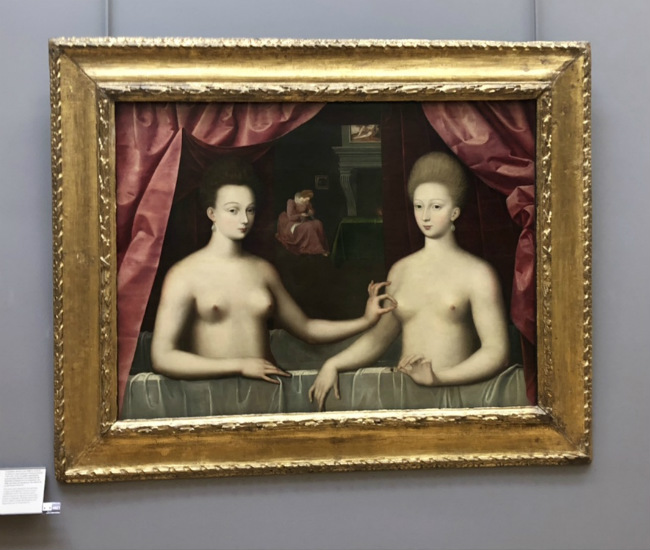
Painting of Gabrielle d’Estrées in the Louvre. Photo: Claudine Hemingway
The painting that is assumed to be of Gabrielle d’Estrées and her sister, the Duchess of Villars, always draws attention and snickers from people of all ages. The actual artist is unknown but is attributed to the School of Fontainebleau and painted in 1594. The mistress and love of Henri IV, Gabrielle is seen here topless while her sister pinches her nipple between her fingers. This was a gesture that symbolized pregnancy, while Gabrielle was pregnant with the son of Henri IV. The César de Vendôme was due at any time, and the king had promised his love that he would marry her. This is why you see the small coronation ring in her left hand, a sign of his love and promise to her. In the background through the curtains (a symbol of royalty, further attaching Gabrielle to the king), sits a woman sewing. Perhaps they are baby clothes. Their tale of love would sadly end when she would die after giving birth to a stillborn son. Henri IV would take the loss very hard and would give her a funeral fit for a queen at Saint-Germain-l’Auxerrois. A very beautiful painting born out of love, these two could never be what they truly wanted to be to each other. Visit Gabrielle d’Estrées in the Richelieu wing, 2nd floor, salle 824.
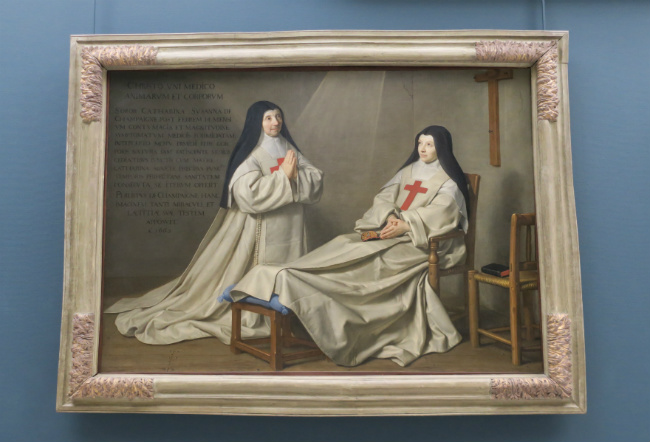
Ex-Voto of 1662 by Philippe de Champaigne. Photo: Claudine Hemingway
If you have visited many of the churches in Paris, you will have noted the small plaques fill many of the chapels with offerings of gratitude. These plaques are called ex-voto and the next painting by Philippe de Champaigne is just that on a much grander scale. Ex-Voto of 1662 depicts the artist’s daughter, Catherine de Sainte-Suzanne, shown seated with her abbess, Mother Catherine-Agnès Arnauld. His daughter had suffered a horrible illness and was nursed back to health from a severe fever that left her paralyzed for 14 months. The painting shows the exact moment of divine recovery with a stream of light coming through the window overhead. The left corner has a written record of the miraculous recovery. The painting that focuses so much on the two figures, use of light and the sentiment from a father, is beautiful. See this lovely painting in the Sully wing, 2nd floor, salle 913.

The Astronomer by Johannes Vermeer. Photo: Claudine Hemingway
Johannes Vermeer, the Dutch Baroque painter, worked slowly, capturing life and painting interior scenes– many of which were in his small house in Delft. Painting The Astronomer in 1668, he painted who we presume to be Dutch scientist Antoine van Leeuvwenhoek looking at a celestial globe while his face and desk are lit from the light streaming in the window. Besides it being a Vermeer and stunning on its own accord, it is the story of what happened in 1940 that adds another level of history to it. Sold to Alphonse James de Rothschild in 1881 and later owned by his son Édouard de Rothschild, it would be confiscated by the Nazis in 1940. Of all the plundering that Hitler was doing throughout Europe, it was this painting that he wanted more than any other. Discovered by the Monuments Men in the Altausee salt mine in Austria, it was returned to the Rothschild family. The French state took possession of it in lieu of inheritance taxes in 1983. Housed in the Louvre since then, the small painting still has a black ink swastika on the back reminding us of its journey. Hanging in the Richelieu wing, 2nd floor, salle 837 where we are so lucky to be able to see it.
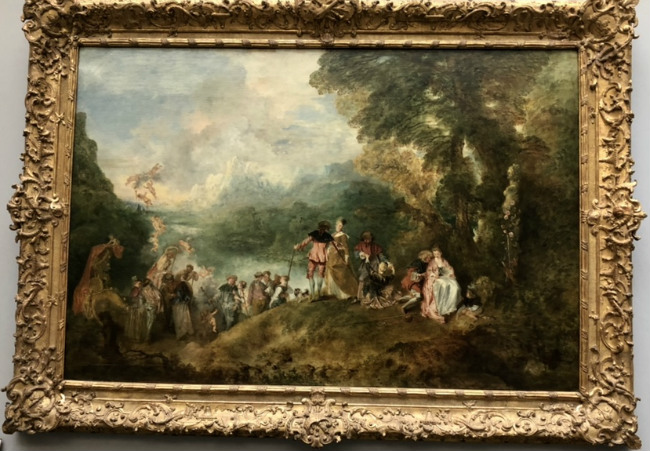
Watteau’s “Pilgrimage to the Isle of Cythera.” Photo: Claudine Hemingway
At the start of the 20th century, French Composer Claude Debussy could be found wandering through the galleries of the Louvre. One painting would draw him in more than any other. Jean-Antoine Watteau, the French Baroque and Rococo painter, would die at only 36 but would create an entire genre. Fête galante, a celebration of the aristocratic crowd, is the style he would create with just one painting: Pilgrimage to the Isle of Cythera. Finished in 1717, the painting depicts the Greek island of Cythera, the birthplace of Aphrodite. The island of love is central to the painting that shows the many stages of courtship. Starting at the right under the watchful eyes of the statue of Aphrodite, a flirting couple are reminiscent of the first stages of love. As they progress from there, they walk together towards the ship, looking back at the younger couple– perhaps remembering how lovely that stage was. The frolicking party makes its way off the island while cupids fly above, reminding us there is still love at that stage. Debussy loved this painting so much he was inspired to write “L’Isle Joyeuse” in 1904. Listening to the piece while looking at the painting you will see exactly what Debussy saw. A truly perfect match. It’s been hanging in the Louvre since the day the doors opened in 1793, in the Sully wing, 2nd floor, salle 917.
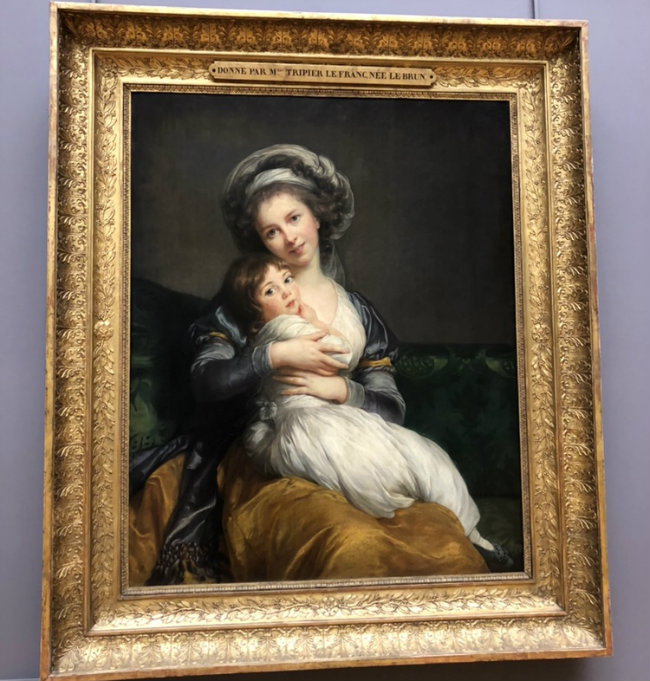
“Madame Vigée-Le Brun et sa fille, Jeanne-Lucie.” Photo: Claudine Hemingway
Élisabeth Vigée Le Brun, the darling of the French court and neoclassical painter, carved her own path in the mostly male world of the pre-Revolutionist period of France. The painter to Queen Marie Antoinette would paint over 30 paintings of the Austrian born queen and her family, but it was a painting of a more personal theme that caused a stir. In 1786 she would paint the self-portrait Madame Vigée-Le Brun et sa fille, Jeanne-Lucie, that would be displayed at the Salon of 1787. It raised quite the controversy, critics condemned it because she painted herself smiling and showing her teeth. It was not her first dance with the artistic elite looking down on her and talking about her in the gossip rags of the day. In the Sully wing on the 2nd floor, salle 933. She painted herself and her daughter again in 1789 just before she they were forced to flee France, this time more relaxed but just as sweet. She can be found in the Denon wing, 1st floor, salle 702.
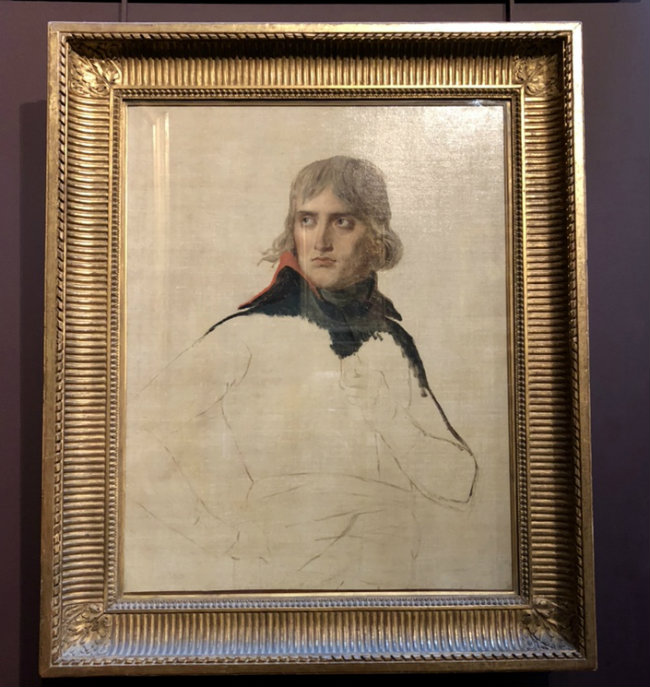
Jacques-Louis David’s Bonaparte. Photo: Claudine Hemingway
In 1797, a young general in the French army would sit in front of artist Jacques-Louis David for his first and only portrait. General Napoleon Bonaparte was 7 years away from being Emperor of France when he sat for David after his triumphant return from the Italian campaign and Battle of Rivoli. Almost unrecognizable from his future portraits, the fair-haired 28-year-old general looks rather dashing. This would be the only portrait that Napoleon would ever sit for and it was never finished. Originally it was a full-size portrait, but Vivant Denon, the first director of the Louvre, had it cut down to show the somewhat completed part. The painting stayed in the collection of Carlos de Beistegui who had bestowed his entire collection to the Louvre with one stipulation that it all must remain together. Located under the ceiling of the Sept-Cheminées, the collection remains intact and is amazing including the next painting.
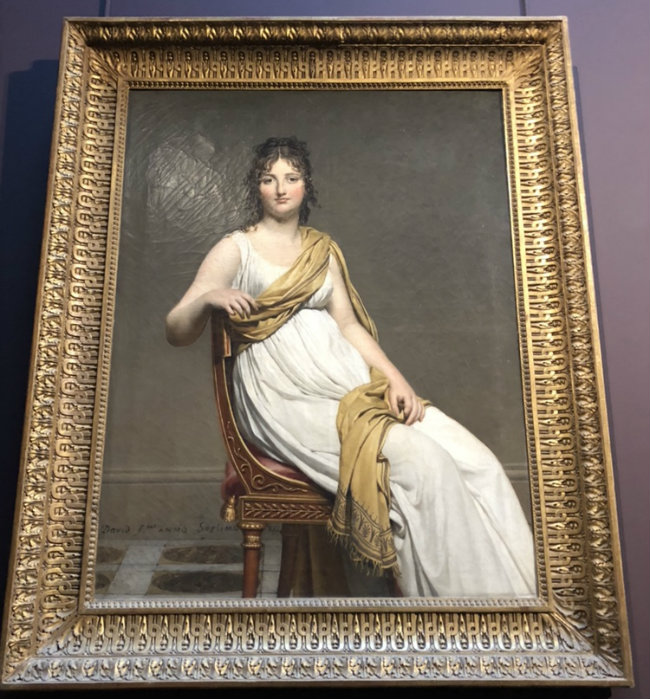
“Madame Raymond de Verninac” by Jacques-Louis David. Photo: Claudine Hemingway
Eugène Delacroix was one of the greatest painters in France and of the Romantic Movement. Now I could provide a top ten list of just his paintings alone, but this final choice is a painting of another Delacroix in the Louvre. His older sister Madame de Verninac, born Henriette Delacroix, was seventeen years older than her brother. Long before her brother picked up a paintbrush, she would sit for Jacques-Louis David. Delacroix was only a few months old while David had survived the Revolution and prison before he became the court painter for Napoleon. The lovely Henriette would sit for the painter at the end of the Directory period in France. A time when the clothing styles were becoming more relaxed and a precursor to the Empire style. In Madame Raymond de Verninac, her relaxed dress has a low neckline and high waist and her gold sash draped over her with thoughts to classic Roman sculpture. Her soft young face and gaze are framed with the carefree curls popular at the time. Her brother would keep this painting with him until his death. Both of the last two paintings can be found in the Sully wing, 1st floor, salle 660.
The Musée du Louvre is filled with many more pieces that have just as interesting of a story behind them. When there, instead of rushing from one room to the next, take your time. Read every plaque, listen to the audio guide, which you can also download on your phone in advance, and read every one of the info cards located in many of the galleries. A story is waiting to be unfolded for you.
Related articles:
10 Things You Must See in the Louvre
News from the Louvre
A Record-Breaking Year at the Louvre Thanks to Bey, Jay-Z and Eug D
The Incredible Frames at the Louvre Museum in Paris
L’Officine Universelle Buly Takes Over the Louvre
Love in the Louvre
Lead photo credit : The Louvre. Photo: Denis McLaughlin/ Flickr
More in Louvre





REPLY
REPLY